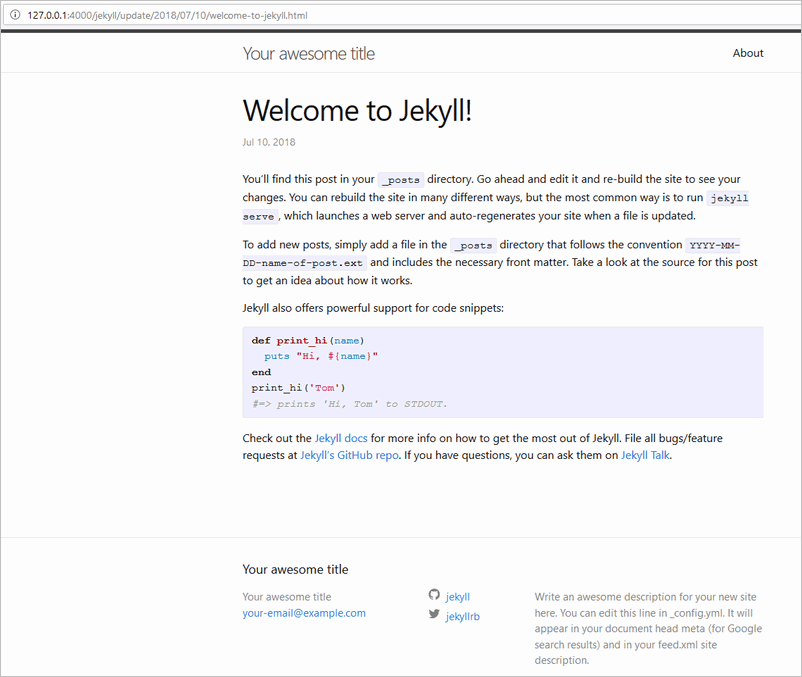

- MAKING A WEBSITE IN RUBY JEKYLL TUTORIAL HOW TO
- MAKING A WEBSITE IN RUBY JEKYLL TUTORIAL INSTALL
- MAKING A WEBSITE IN RUBY JEKYLL TUTORIAL UPDATE
This will simply update the value of theme in _config.yml. There is a button labelled "Change Theme" that will take you to a selection of themes you can use. In your repository, click on "Settings" and scroll down to "GitHub Pages". Changing theme on GitHubĬhanging a theme on GitHub is even simpler. So pages will need to updated to fit the theme requirements. Then update your bundle before launching the Jekyll server.īe sure to read the warnings and errors as not all themes use the same layouts. To use the Cayman theme you would add theme: jekyll-theme-cayman to _config.yml and gem "jekyll-theme-cayman" to Gemfile. You also need to update your Gemfile to download the theme by adding gem. If you want to try out a different theme locally you need to update the value of theme in _config.yml. The default theme in Jekyll is Minima (which was used for the first example), but there are huge number of Jekyll themes available online. The easiest way to get started is by using a theme.
MAKING A WEBSITE IN RUBY JEKYLL TUTORIAL HOW TO
Now that you know how to make and deploy a basic website you will probably want to personalise it to fit your needs and taste. Once your site is deployed it will be visible at Customising your website You can create a website for your GitHub organisation in exactly the same way. You can find my website here: Organisation website Once your site is deployed it will be visible at e.g. Since the site is not linked to a normal repository, you won't have to specify the baseurl in _config.yml. So you can prepare your Jekyll site in pretty much the same way. The master branch of this repository will behave in the same way as the gh-pages branch in the example. one linked to your GitHub username) you need to create a new repository on your GitHub account called. To create your own personal website ( i.e.

There is, however, another way in which you can create your own personal website or one for a GitHub organisation. In the first example we looked at how to deploy a basic Jekyll site on the gh-pages branch of any given repository. Now you should be able to view your example site at If you forked this repository it will be Note it may take a few minutes before the website is available. With Ruby installed the installation of Jekyll should simply be:

Jekyll is written in Ruby and therefore your system must have Ruby installed in order to build Jekyll.
MAKING A WEBSITE IN RUBY JEKYLL TUTORIAL INSTALL
Installationīefore starting you will have to install Jekyll. It is also possible to build your website entirely on GitHub, but you will save yourself a lot of time if you are able to test things locally before deployment. You will also need to install Jekyll (see the next section) for local development and testing. It is possible to run everything locally and deploy your website on a different server, but everything will presented under the assumption that you already have a GitHub account. To follow all of the steps in this tutorial you will need a GitHub account. Email: objective of this tutorial is to introduce Jekyll and show you how to build a website that you can host on GitHub for free.


 0 kommentar(er)
0 kommentar(er)
